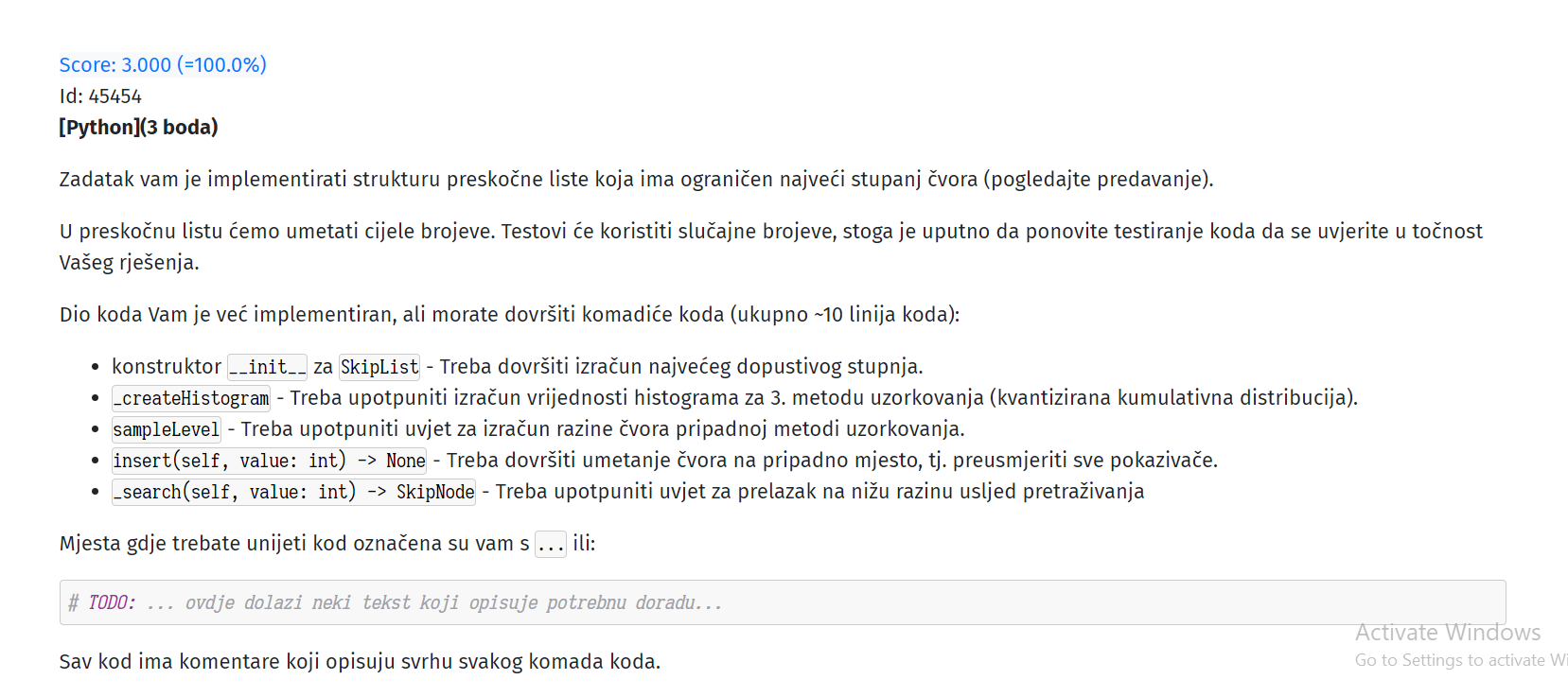
import random
from math import ceil, floor, log
from typing import List
class SkipList:
"""Class for skip list
"""
def __init__(self, n: int = 10000, p: float = 0.5):
"""Creates skip list and initializes all the necessary
parameters
Args:
n (int, optional): expected capacity. Defaults to 10000.
p (float, optional): probability of jumping up by one level. Defaults to 0.5.
"""
self.p = p
self.n = n
self.max_level = # TODO: fix calculation for max_level
self.head = SkipNode(None)
self.head.pointers = [None]*self.max_level
self.histogram = self._createHistogram()
def _createHistogram(self) -> List:
"""Creates histogram of degrees.
Returns:
List: histogram according to the third method from the lecture
"""
H = [0]*(self.max_level+1)
for i in range(1, self.max_level+1):
H[i] = # TODO: fix value for the histogram
return H
def sampleLevel(self) -> int:
"""Randomly decides the height of the node,
according to the histogram, using only one sample!
Returns:
int: returns valid randomly selected height
"""
ctoss = random.randint(1, self.n)
i = 1
while # TODO: fix the condition for sampling!
i += 1
return i
def insert(self, value: int) -> None:
"""Inserts an element into the skip list if it has not already existed.
Duplicates are not allowed.
Args:
value (int): key to insert into the skip list
"""
level = self.sampleLevel()
pred_node = self._search(value)
if pred_node.value == value:
return
succ_node = pred_node.pointers[0]
new_node = SkipNode(value, pred_node=pred_node)
new_node.pointers = [None]*level
new_node.pointers[0] = succ_node
#TODO: update all the pointers on necessary levels.
# Hint: Also use pred_node for backsearch over the levels to update. Or, use alternative way!
def _search(self, value: int) -> SkipNode:
"""Searches for the element in a list
Args:
value (int): search key
Returns:
SkipNode: skiplist node containing the search key, if it exists.
Otherwise it returns the last element of the skip list.
"""
node = self.head
curr_height = len(node.pointers)-1
while curr_height >= 0:
next_node = node.pointers[curr_height]
if next_node is None or #TODO: add the missing condition here
curr_height = curr_height-1
else:
node = next_node
return node
def search(self, value: int) -> SkipNode:
"""tidy wrapper around _search
Args:
value (int): search key to find
Returns:
SkipNode: Returns the found node or None.
"""
node = self._search(value)
if node.value == value:
return node
else:
return None
def __str__(self) -> str:
"""string representation of skip list - useful for debugging
Returns:
str: string representation
"""
curr_node = self.head.pointers[0]
str = ''
while curr_node is not None:
str = str + \
f"(Node {curr_node.value},level={len(curr_node.pointers)}),"
curr_node = curr_node.pointers[0]
return str
class SkipNode:
"""Class for a node in skip list
predecessor - pointer to predecessor node on THE lowest level.
pointers - pointers to successors (over full height of the node)
value - value stored in the node
"""
pointers, value, predecessor = None, None, None
def __init__(self, value: int, pred_node: 'SkipNode' = None, succ_node: 'SkipNode' = None):
"""Creates skip node for skip list.
Args:
value (int): value to be stored
pred_node (SkipNode, optional): predecessor node on the lowest level. Defaults to None.
succ_node (SkipNode, optional): successor node on the lowest level. Defaults to None.
"""
self.value = value
self.pointers = [None]
if pred_node is not None:
pred_node.pointers[0] = self
self.predecessor = pred_node
if succ_node is not None:
self.pointers[0] = succ_node
succ_node.predecessor = self
njihov kod za testni primjer
random.seed(22)
a = SkipList(18, 0.6)
print(f'histogram={a.histogram}, max level={a.max_level}')
a.insert(12)
a.insert(18)
a.insert(16)
a.insert(18)
a.insert(281)
a.insert(-1)
a.insert(0)
print(a)
"""ispisuje:
histogram=[0, 8, 12, 15, 16, 17, 18], max level=6
(Node -1,level=1),(Node 0,level=2),(Node 12,level=1),(Node 16,level=1),(Node 18,level=1),(Node 281,level=1),
"""
random.seed(23)
a = SkipList(12, 0.5)
print(f'histogram={a.histogram}, max level={a.max_level}')
a.insert(12)
a.insert(18)
a.insert(16)
a.insert(18)
a.insert(281)
a.insert(-1)
a.insert(0)
print(a)
"""ispisuje:
histogram=[0, 6, 9, 11, 12], max level=4
(Node -1,level=2),(Node 0,level=2),(Node 12,level=1),(Node 16,level=1),(Node 18,level=1),(Node 281,level=1),
"""
izvinite što se sjebano kopiralo, ugl puno pomaže što uopće ne morate raditi ovaj TODO u insertu tak da ukupno morate cca 5 linija koda napisat, riješi se za 10 min ko zna gradivo, ko ne zna ko ja onda malčice duže